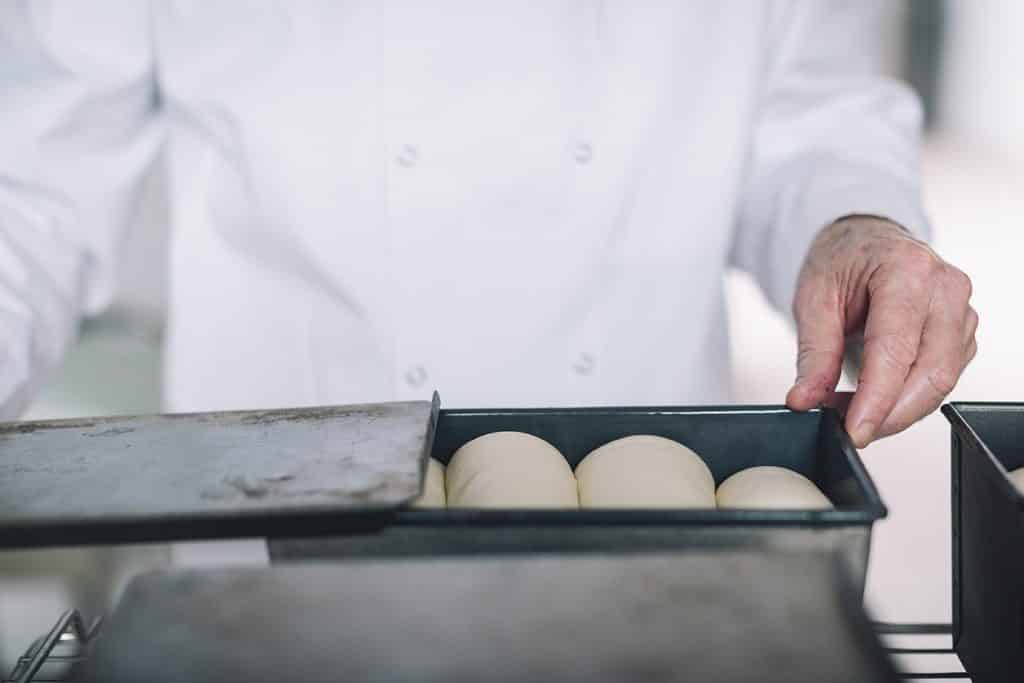The gas volume resulting from CO2 production.
Volume is a decisive quality criterion in many bakery goods. The development of a dough mass, and therefore the volume of the finished bakery good, is dependent upon two factors: the volume of carbon dioxide gases produced under the effect of yeast fermentation and the gas retention capacity. This article takes a look at the mechanisms responsible for CO2 production.
What is responsible for the swelling of dough?
The swelling of a dough mass is caused by the production of carbon dioxide (CO2) during the different stages of fermentation. Said fermentation is primarily brought about by the yeast present in dough and its action on the sugars it uses as substrates. The fermentable sugars naturally present in flour are rapidly exhausted and gradually followed by other sugars produced from starch thanks to the action of the enzymes present in flour, namely amylases.
The role of alcoholic fermentation in gas thrust
During the fermentation process, the yeasts present in the dough (primarily Saccharomyces cerevisiae) convert the simple sugars (glucose and fructose) into alcohol and carbon dioxide: this is the process known as alcoholic fermentation.
The gases thus formed are responsible for the development undergone by the dough during final proofing, before it enters the oven. The bubbles of CO2 trapped inside the dough will form the air holes dispersed throughout the crumb after the loaf is baked.
The sugars responsible for ensuring gas production
Alcoholic fermentation, and therefore the production of CO2 and the achievement of volume, depends upon the presence in flour of different types of sugar, which are successively employed by the yeast as substrates:
- Simple sugars
Flour contains a few simple sugars (monosaccharides and disaccharides), which can be initially employed by the yeast. These sugars are generally found in limited amounts in dough and are rapidly exhausted by the fermentative metabolism of the yeast. The result is a temporary slowdown in CO2 production.
- Starch
Once the simple sugars in the dough have been exhausted, the polysaccharide found in significant quantities in flour, known as starch, becomes the major source of the sugars required for alcoholic fermentation. However, for starch to be utilizable by yeast, it must first be hydrolysed into smaller molecules by the action of the enzyme amylase. The amylases swing into action from the mixing stage and until they are denatured by the effect of heat during oven baking (Pyler and Gorton, 2008). The broken-down starch brings about the availability of new simple sugars (maltose and glucose), which are immediately employed as substrates by the yeast, thereby restarting the fermentation and gas production processes.

The role of the gluten network in improving gas retention
Volume is a decisive quality criterion in many bakery goods. Two factors are responsible for that volume: firstly, the volume of gases produced during the final proofing under the effect of fermentation; secondly, the gas retention capacity, not just during final proofing, but also during the first few minutes of baking, during which time the dough mass will swell and stabilize at its final volume (Inra, 1994). This article takes a look at the mechanisms responsible for gas retention in bread dough.
The role of gluten in improving gas retention in dough
While the carbohydrates in flour, in their capacity as substrates for fermentation, play a major role in the production of the gases required for obtaining volume, (see. Short text The gas volume resulting from CO2 production), it is the wheat proteins that will ensure their retention in the dough.
The glutenins and gliadins in dough are what helps to produce the visco-elastic protein network known as gluten. The gluten is formed through the hydration of the flour during mixing. Many types of bonds exist between gliadins and glutenins, of which the most robust are the disulfide bridges (covalent bonds). These play a key role in ensuring the network’s cohesion.
How is the gluten network formed in breadmaking?
The mixing process is organised into several stages during which the gluten network is gradually formed (Le Blanc, 2007):
- the basic mixing stage consists in mixing the basic ingredients together. In the process, water is dispersed throughout the flour particles and absorbed by the gluten proteins and starch;
- intensive or high-speed mixing consists in subjecting the dough in the mixer to all kinds of mechanical actions, such as shearing, stretching and compression, as well as beating (during which air is incorporated). It is during this last phase that the gluten network is formed and imprisons the starch grains. The air trapped in the dough during the beating phase forms micro air-holes, which will serve as niches for the CO2 produced as a result of fermentation. A correctly structured gluten network will result in optimum gas retention, which in turn improves dough development.
Softening of gluten
Some especially strong flours can give rise to the development of short gluten that is lacking extensibility, for which there are three technical remedies:
- An intermediate autolytic stage, added between the basic and intensive/high-speed mixing phases can improve the end result. This technique consists in making a dough from flour and water alone, and leaving it to rest for 15 minutes to several hours after basic mixing, or after a few minutes of intensive mixing. During this time, the gluten proteins undergo hydrolysis through the action of the proteases in the flour. This helps to relax the gluten network and increase its extensibility, thus resulting in increased volume and consistency in the end products (the extensibility of the dough reduces the resistance to gas thrust).
- Yeast-based pre-fermentation techniques, which consist in making a sponge from a mixture of water, flour and baker’s yeast and which have the same effect in terms of softening the gluten.
- Addition of deactivated yeast, which limits the formation of disulfide bridges between the gluten filaments. The protein chains slide in and out of each other more readily, thus promoting volume and reducing shrinkage in the dough balls.




